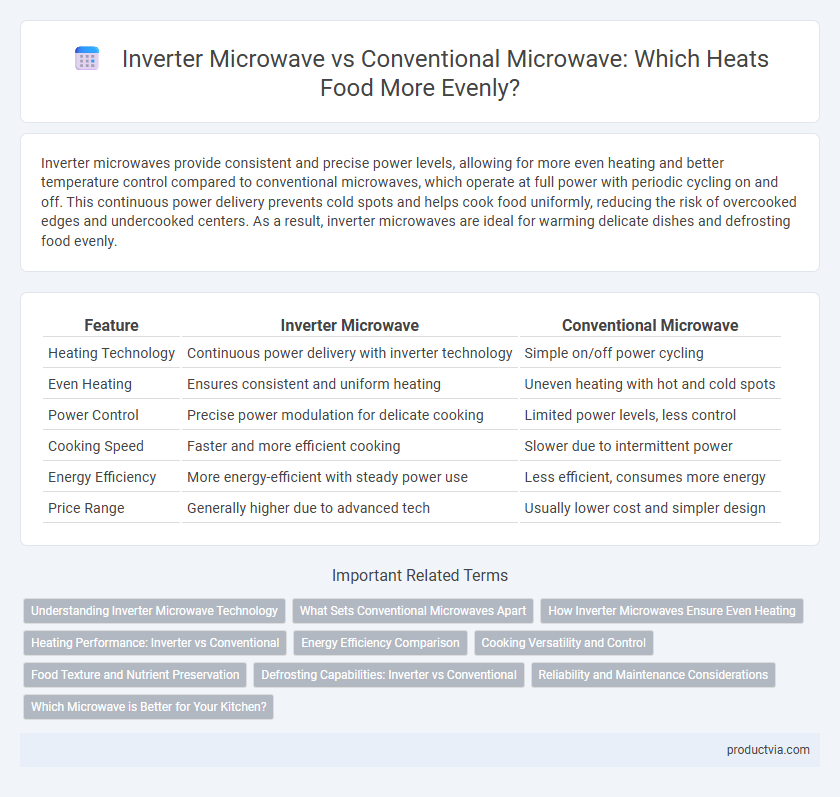Inverter microwaves provide consistent and precise power levels, allowing for more even heating and better temperature control compared to conventional microwaves, which operate at full power with periodic cycling on and off. This continuous power delivery prevents cold spots and helps cook food uniformly, reducing the risk of overcooked edges and undercooked centers. As a result, inverter microwaves are ideal for warming delicate dishes and defrosting food evenly.
Table of Comparison
| Feature | Inverter Microwave | Conventional Microwave |
|---|---|---|
| Heating Technology | Continuous power delivery with inverter technology | Simple on/off power cycling |
| Even Heating | Ensures consistent and uniform heating | Uneven heating with hot and cold spots |
| Power Control | Precise power modulation for delicate cooking | Limited power levels, less control |
| Cooking Speed | Faster and more efficient cooking | Slower due to intermittent power |
| Energy Efficiency | More energy-efficient with steady power use | Less efficient, consumes more energy |
| Price Range | Generally higher due to advanced tech | Usually lower cost and simpler design |
Understanding Inverter Microwave Technology
Inverter microwave technology delivers consistent and precise power levels, ensuring even heating by continuously adjusting the energy output. Unlike conventional microwaves that operate with full power cycling on and off, inverter microwaves provide steady, uninterrupted heat, which prevents overcooking and cold spots. This advanced technology enhances cooking accuracy, making it ideal for defrosting, reheating, and cooking delicate foods evenly.
What Sets Conventional Microwaves Apart
Conventional microwaves operate with a fixed power output, cycling the magnetron on and off to control heat, which can lead to uneven cooking and hot spots in food. This intermittent heating method distinguishes them from inverter microwaves, which provide continuous and variable power for consistent temperature maintenance. The ability of conventional microwaves to deliver high peak power in bursts makes them faster at heating certain foods but less effective for delicate or uniform cooking.
How Inverter Microwaves Ensure Even Heating
Inverter microwaves utilize a precise power control system that delivers continuous and consistent energy, allowing food to heat evenly without overcooking edges. Conventional microwaves operate using a simple on/off power cycle, causing fluctuating energy levels that lead to uneven heating and cold spots. The advanced inverter technology ensures a steady distribution of microwaves, which maintains uniform temperature throughout the cooking process.
Heating Performance: Inverter vs Conventional
Inverter microwaves deliver consistent and precise power levels, resulting in more even heating and better cooking performance compared to conventional microwaves, which cycle power on and off. This continuous power delivery prevents hot and cold spots often found in conventional models, ensuring food is heated uniformly. The inverter technology allows for delicate cooking tasks by maintaining steady temperatures, enhancing overall heating accuracy and efficiency.
Energy Efficiency Comparison
Inverter microwaves utilize variable power levels to deliver consistent and even heating, reducing energy waste compared to conventional microwaves that operate by cycling power on and off. This precise control in inverter technology enhances energy efficiency by maintaining optimal cooking temperatures without frequent stops and starts, leading to faster cooking times and lower electricity consumption. Consequently, inverter microwaves offer superior energy savings while ensuring evenly heated food, making them a more sustainable choice for everyday use.
Cooking Versatility and Control
Inverter microwaves deliver consistent power levels that enable precise temperature control and even cooking, enhancing cooking versatility for delicate dishes like melting chocolate or simmering sauces. Conventional microwaves operate with a fixed power cycle, causing uneven heating and limiting control over cooking results. This advanced inverter technology ensures uniform heat distribution, allowing more accurate adjustments and broader culinary applications.
Food Texture and Nutrient Preservation
Inverter microwaves provide consistent power delivery that ensures even heating, preserving food texture by preventing overcooking or drying out. This steady energy flow retains more nutrients compared to conventional microwaves, which use alternating full-power cycles causing uneven heating and potential nutrient loss. Optimized for nutrient preservation and food quality, inverter microwaves enhance meal texture and maintain essential vitamins better than traditional microwave models.
Defrosting Capabilities: Inverter vs Conventional
Inverter microwaves provide precise power control, enabling consistent and even defrosting that prevents partially cooked edges and frozen centers common in conventional microwaves. Conventional microwaves operate at full power cycles, causing uneven heat distribution and longer defrosting times. The advanced inverter technology ensures delicate foods defrost uniformly, preserving texture and reducing the risk of bacterial growth.
Reliability and Maintenance Considerations
Inverter microwaves provide consistent power levels, ensuring even heating and reducing the risk of hot spots compared to conventional microwaves that use full power cycling. Their advanced technology tends to require less frequent repairs, enhancing reliability over time. Maintenance is generally straightforward, but inverter microwaves may involve higher service costs due to more complex electronics.
Which Microwave is Better for Your Kitchen?
Inverter microwaves provide evenly distributed heat by delivering consistent power levels, resulting in better cooking precision and preventing overcooked edges or cold spots compared to conventional microwaves that cycle power on and off. The advanced technology in inverter microwaves improves food texture and reduces cooking times, making them ideal for recipes requiring delicate heating or thawing. For kitchens prioritizing efficiency and uniform cooking, inverter microwaves offer superior performance over traditional models.
Inverter Microwave vs Conventional Microwave for even heating Infographic

 productvia.com
productvia.com